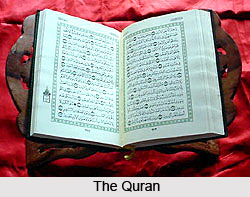 The literal meaning of Islam is peace; surrender of one`s will i.e. losing oneself for the sake of God and surrendering one`s own pleasure for the pleasure of God. The message of Islam was revealed to the Holy Prophet Muhammad 1, 400 years ago. It was revealed through angel Gabriel and was thus preserved in the Holy Quran. The Holy Quran carries a Divine guarantee of safeguard from interpolation. It claims that it combines the best features of the earlier scriptures.
The literal meaning of Islam is peace; surrender of one`s will i.e. losing oneself for the sake of God and surrendering one`s own pleasure for the pleasure of God. The message of Islam was revealed to the Holy Prophet Muhammad 1, 400 years ago. It was revealed through angel Gabriel and was thus preserved in the Holy Quran. The Holy Quran carries a Divine guarantee of safeguard from interpolation. It claims that it combines the best features of the earlier scriptures.
Islam believes that each person is born pure. The Holy Quran tells us that God has given human beings a choice between good and evil and to seek God`s pleasure through faith, prayer and charity. Islam believes that God created mankind in his image and by imbuing the attributes of God on a human level, mankind can attain his nearness. Islam`s main message is to worship God and to treat all God`s creation with kindness and compassion including Rights of parents in old age, orphans and the needy. Women`s rights were safeguarded 1,400 years ago when the rest of the world was in total darkness about liberaion. Islamic teachings encompass every imaginable situation. Its rules and principles are truly universal and have stood the test of time.
Quran
The Quran contains the spoken words of Allah. The Quran is revealed in the Arabic language and it is noted for its unmatched Excellency in language. It has 114 chapters that are not chronologically arranged. The different pronouncements by the Prophet at different intervals were recorded and arranged in their present form by orders of Caliph Uthman (645-656). The prophet was not a man of letters. Therefore, the utterances in the Quran are considered to be genuine speech of God himself.
The Quran is the most sacred books of the Muslims. They strive to learn it by heart and refer to it for all teachings about God, Angels, the Prophet, Resurrection, the day of reckoning and the theory of heaven and hell. The Quran contains the final and definite revelation of God`s Will for the guidance of man. It is the foundation of the whole Islamic structure.
The Quran has taught man to believe that God had chosen Muhammad as his messenger and that he preached what God had revealed to him. The simple and clear-cut message of Islam, that there is no God but Allah, and that life should be lived in complete submission to the will of Allah attracted many people, and they flocked to hear it.
The people in power in Mecca saw Muhammad`s popularity as a threat. Muhammad took his followers on a journey from Mecca to Medina in 622 called the Hijrah (migration) and the event was considered so important for Islam that 622 from then on is considered to be the year in which the Islamic calendar began. Thus Quran clearly states the importance of the Hijra.
Muslims are those who declare that there is no deity except Allah, which in Arabic means God, and that Muhammad is his messenger. They give themselves completely in obedience to Allah and mould their lives according to the teachings of the Holy Quran and prophet Muhammad.



















